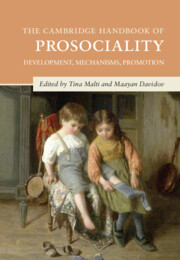Book contents
- The Cambridge Handbook of Prosociality
- Cambridge Handbooks in Psychology
- The Cambridge Handbook of Prosociality
- Copyright page
- Dedication
- Contents
- Figures
- Contributors
- Part I Development of Prosociality
- Part II Antecedents and Mechanisms of Prosociality
- Part III Development of Prosociality in Context
- 18 Parenting and Children’s Prosociality
- 19 Sibling Influences on Prosociality
- 20 Prosocial Behavior, Peer Relationships, and Friendships
- 21 Children’s Intergroup Prosocial Behavior
- 22 Prosocial Behavior in School Contexts
- 23 Community and Neighborhood Influences on Prosociality in Children and Youth
- 24 Culture and Prosociality
- 25 Prosocial Media
- Part IV Applications
- Index
- References
23 - Community and Neighborhood Influences on Prosociality in Children and Youth
from Part III - Development of Prosociality in Context
Published online by Cambridge University Press: 25 May 2023
- The Cambridge Handbook of Prosociality
- Cambridge Handbooks in Psychology
- The Cambridge Handbook of Prosociality
- Copyright page
- Dedication
- Contents
- Figures
- Contributors
- Part I Development of Prosociality
- Part II Antecedents and Mechanisms of Prosociality
- Part III Development of Prosociality in Context
- 18 Parenting and Children’s Prosociality
- 19 Sibling Influences on Prosociality
- 20 Prosocial Behavior, Peer Relationships, and Friendships
- 21 Children’s Intergroup Prosocial Behavior
- 22 Prosocial Behavior in School Contexts
- 23 Community and Neighborhood Influences on Prosociality in Children and Youth
- 24 Culture and Prosociality
- 25 Prosocial Media
- Part IV Applications
- Index
- References
Summary
There is limited research examining community and neighborhood influences on prosociality in children and youth. In this chapter we outline three relevant theories that address how neighborhood and community processes influence prosocial behavior and review the empirical literature on the topic. Our review suggests that measures of neighborhood socioeconomic status, demography, and disorder have little direct association with prosociality in children and youth but that adolescent prosocial behavior is linked to social capital and collective efficacy. The community intervention evidence shows that providing increased opportunities for prosocial involvement may support greater prosocial behavior of adolescents, possibly by boosting community social capital. Further development of more specific theoretical models and further empirical research is required to better understand the complex neighborhood and community mechanisms across neighborhoods, cities, nations, and cultures.
Keywords
- Type
- Chapter
- Information
- The Cambridge Handbook of ProsocialityDevelopment, Mechanisms, Promotion, pp. 459 - 476Publisher: Cambridge University PressPrint publication year: 2023



